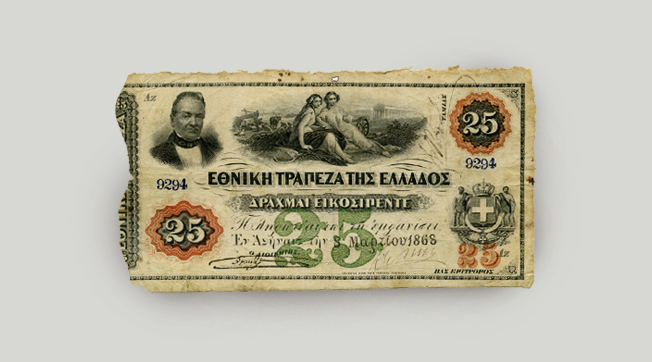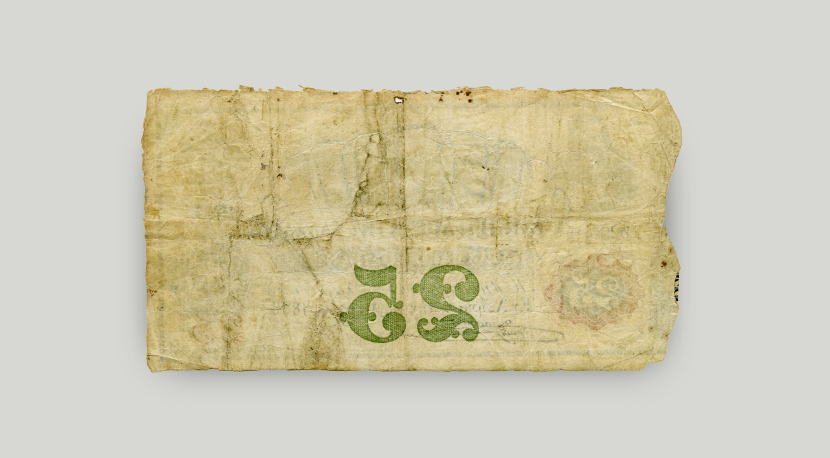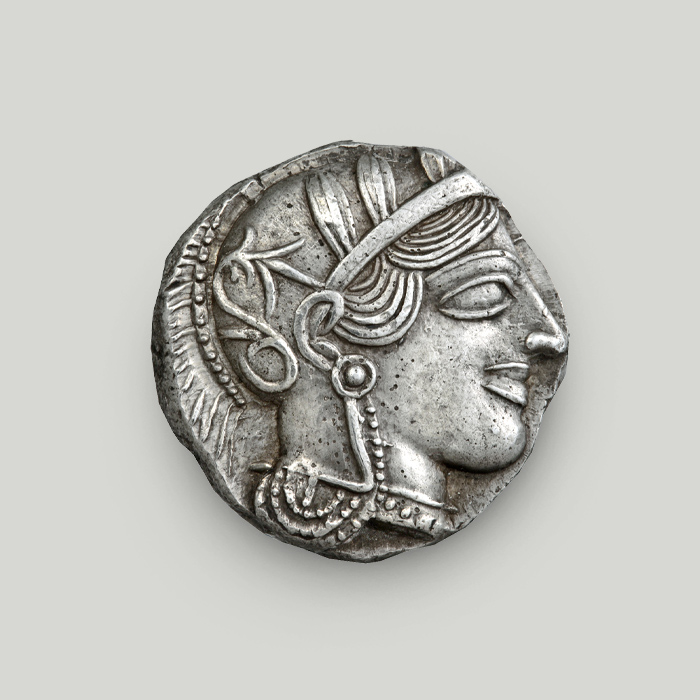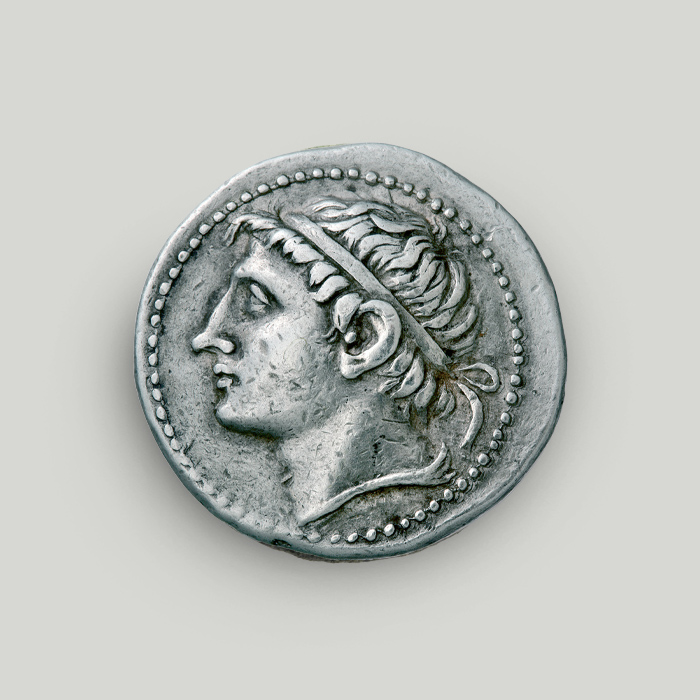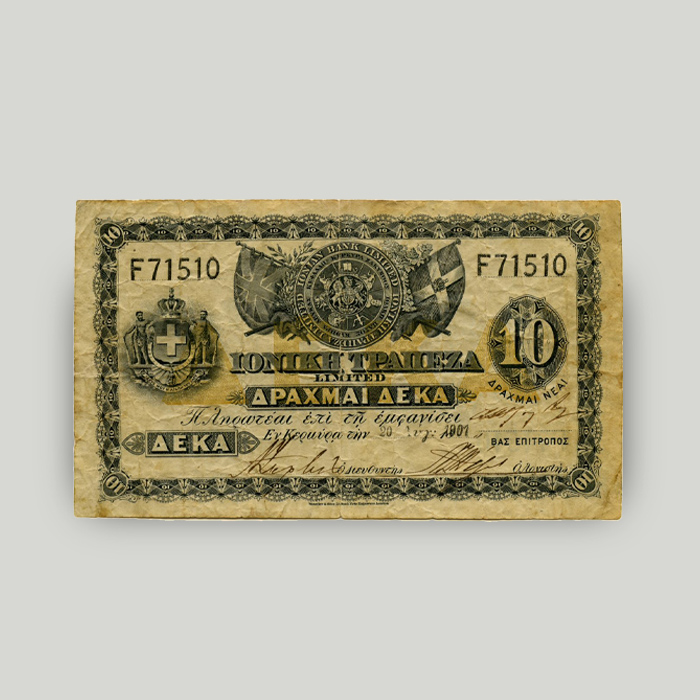25 drachma banknote, 1868
The 25-drachma banknote, issue 4b of the National Bank of Greece was put in circulation on 8 March 1868. The National Bank was established on 30 March 1841 by royal decree. It had the exclusive right to issue paper money (banknotes) in drachmas for the Greek state. The banknotes in the 4th issue were the first to be printed in multicolour and the last to be printed on one side only (uniface).
Face
Top left: Georgios Stavros, Governor of the National Bank of Greece. Top centre: the female personifications of Agriculture and Cottage Industry, sitting in a meadow with tools of their respective trades around them. A Doric-style temple can be seen in the background. Bottom right: the coat of arms of King George I of Greece.
Other printed elements include the inscription “NATIONAL BANK OF GREECE” (in Greek), the value in numerals and words, the circulation date and the number “9294”. Also, the signatures of the Bank Governor, the Royal Commissioner and the Treasurer, as well as the printing company name “AMERICAN BANK NOTE COMPANY” in small print at the bottom.
The left-side cut is irregular.
Back
White (blank). The only visible element is the value numeral, which is printed on the face and, therefore, appears reversed.
Establishing the National Bank of Greece
As the Greek economy was being rebuilt, King Otto envisioned the establishment of a bank. The new bank would promote growth in agriculture, manufacturing, commerce and seafaring.
Kapodistrias’ earlier established National Trading Bank (1828-1834) had failed after spending all its funds to cover the young state’s staggering needs in cash.
After a series of fruitless efforts, Otto’s idea caught the eye of Swiss philhellene Jean-Gabriel Eynard. Eynard worked closely with Georgios Stavros, his proxy in Greece, to launch the new bank, originally named National Hellenic Bank.
It was established by royal decree on 30 March 1841, with Stavros as its first Governor.
The exclusive issuing right
The National Bank had the exclusive right to issue drachma banknotes for the Greek state. It maintained this right until 1928, when a new central bank, the Bank of Greece, was established.
From 1841 to 1928, the National Bank circulated 13 issues that included 71 different banknotes, at denominations ranging from 1 to 5,000 drachmas.
The first drachma banknotes
The first issue of paper drachmas was in 1842 and included 4 denominations: 25, 50, 100 and 500 drachmas.
The notes were printed in France under the supervision of Jean-Gabriel Eynard. They were only printed on one side (uniface) and were numbered by hand.
The people finally endorsed the concept of paper money, which contributed to a new-found sense of national identity and unity in the young Kingdom of Greece.
Later on, the need arose to issue banknotes in denominations smaller than 25 drachmas. Besides, stronger measures against counterfeiting had to be adopted. These factors led to the 2nd issue of banknotes carried out over 1849 and 1850. A 3rd issue followed in 1851.
The 4th issue
In 1859 it was decided that a new issue was in order. The American Bank Note Company in New York printed the banknotes of this 4th issue.
The elements depicted were markedly different to those on the previous Greek notes. It was decided that Georgios Stavros, the Bank Governor, would be depicted on all notes, along with the royal coat of arms, “to easier diagnose [counterfeits]”, according to the Bank’s statement.
On 25- and 100-drachma notes, the denomination was printed in characters visible on both sides of the note. Therefore, the denomination was also readable on the unprinted back. To achieve this, ink that bled to the unprinted side was used.
The banknotes of the 4th issue were irregularly cut on the left-hand side to easily distinguish counterfeits.
Georgios Stavros: the first Governor of the National Bank
Georgios Stavros (1788-1869) was the first Governor of the National Bank and remained in this post for 27 years. He was a merchant, an economist, a banker and a member of the Society of Friends (Filiki Eteria). This secret revolutionary society was founded in Odessa in 1814 with the aim of overthrowing the Ottoman rule in Greece and establishing an independent Greek state.
Stavros supported the 1821 Greek War of Independence and undertook much charitable work. He died of a heart attack at the National Bank headquarters, where he worked and lived.
Quite a special issue
The banknotes of the National Bank’s 4th issue were the first to be printed in multicolour.
They were also the last to be printed on one side only (uniface).
The royal coat of arms
The royal coat of arms is depicted at the bottom right of the banknote. Every time a new king was crowned, the coat of arms changed, too.
Therefore, the coat of arms printed on issue 4a was that of Otto, while the one printed on 4b was that of George I.
The banknote in our publications
The note is mentioned in the book Greek Banknotes. Historical Evidence by Dr Dimitra Tsangari. The publication includes the paper money put in circulation throughout the history of the newly-established Greek state: banknotes, coin notes and relevant material. It spans over 180 years of history. A timeline presents key moments in Greek history that were linked to currency circulation.
Buy the publication Greek Banknotes. Historical Evidence on the Alpha Bank e-shop.
The 25-drachma banknote of 1869 is on display at the Banknote Museum of Ionian Bank in Corfu, managed by Alpha Bank.
The exhibit is open to the general public. View the Museum opening hours.
